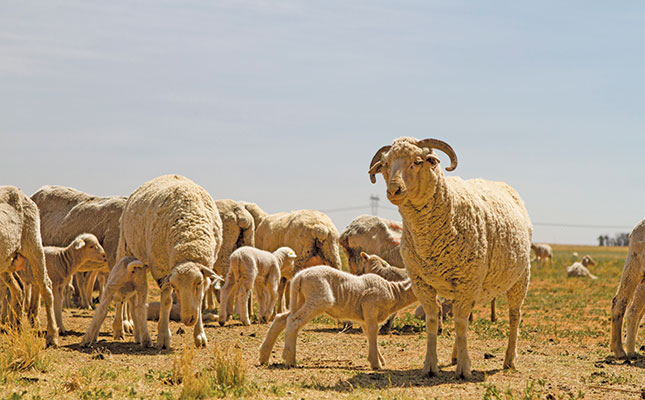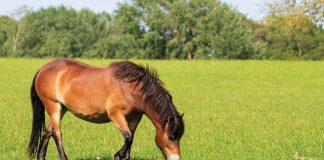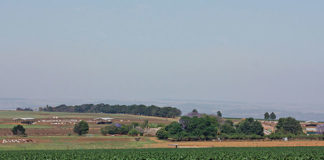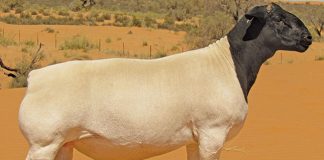
Photo: Sabrina Dean
Le Roux Fourie, who farms in the Brandfort district of the Free State, believes that the only way to produce more is by optimising resources to unlock their full value. In a summer cropping area, he says, the best way to achieve this is through a sheep component, specifically wool sheep.
“Brandfort is involved in cropping, but we don’t have high-potential lands. We’re more marginal than places where they have so-called water-table lands,” he explains.
Therefore, rather than trying to compete in the high-risk and variable cropping business, he uses his cropping component to add value to his sheep production.
“My view is that with different practices, such as bringing in wool sheep, I’ll be able to optimise those lands.”
A stable product line
According to Fourie, wool can serve as a “stabiliser” to the up-and-down business of cropping; put another way, he uses his wool component as a way of hedging against risk. This method is used by most retailers.
“If you look at a retail business plan, the owners always have a product line that brings stability to the business. They want that consistency: the bread, milk and eggs for which customers come into the shop every day. You want to bring something like that into your farming operation too.”
He views his sheep component as a best-of-both commodity as its provides two products: meat and wool. His meat income is driven largely by domestic demand.
“Wool is priced on the international market. It’s also a niche product at this stage, and it’s always good to have a niche product.”
Variety of crops
Fourie’s sheep operation comprises a Merino stud and a commercial herd. He also operates a feedlot and does backgrounding of wethers on croplands when the right opportunity presents itself.
Approximately one-third of his lands are used to produce cash crops such as yellow maize, sunflower and wheat. The other two-thirds comprise grazing, grain crops or green feed, which he plants for the sheep.
“We grow grazing maize, feed sorghum, cow peas, radishes and oats. I’m also in the process of re-establishing dryland lucerne, and plant a lot of teff to use in the lambing system and the feedlot.”
He uses some of the crops in his feed mixes, and sells the surplus to a nearby chicken farm.
He prefers planting maize rather than sunflower in summer, as this also provides residue for the sheep to graze.
However, if climate challenges dictate, he plants sunflower.
“I planted maize late this year. I didn’t harvest much, but the residue is of cardinal importance in the business. It fits into our entire winter feed process.”
Stud and commercial
The stud and commercial ewes run together on the veld, and are managed in line with a feed flow management system that includes factors such as carrying capacity, rainfall, the feed potential of a land, and at what stage of gestation the sheep is at. High-potential ewes receive special treatment.
“If a ewe has been scanned with triplets, then I look after her,” explains Fourie. “I might put her on a ration by placing her on a feed land with good potential, or place her in a smaller camp.
“There are two approaches. In one, you take the feed to the sheep. In the other, you take the sheep to the feed, which is why it’s useful to have croplands as part of a feed system.”
Ewes scanned with single lambs lamb on the veld, regardless of whether they are part of the stud or the commercial flock.
Fourie has two lambing seasons a year for his stud sheep: one in April and the other in September. He keeps a small herd of breeding rams from which he obtains semen for artificial insemination. He also makes use of teaser rams during breeding.
The commercial herd is managed on an accelerated lambing system.
“I’ve started implementing a system whereby they lamb every eight to nine months, or three times in two years,” he says.
Fourie also uses rams from other breeds, such as the Suffolk, on his commercial ewes to produce crossbred animals for slaughter.
“I like the Suffolk crosses because they give better growth,” he says. Suffolk sheep offer the added advantage of having no kemp in their wool.
Replacement ewes for the commercial herd are provided by the stud herd.
“I keep about 20% of my stud ewes as replacement ewes for the stud and commercial herds, with a full replacement cycle spread over about five years.”
Selection and performance
Approximately 40% of Fourie’s sheep are stud animals, and the remainder commercial. He carries out performance recordings on all his animals, and ensures that full BLUP analysis is done on stud animals by submitting relevant recordings to SA Stud Book.
The BLUP traits for the Merino include an economic value for reproduction in the formula, which gives a breeder an indication of the mothering traits of a ewe, as well as factors such as consistency, weaning heavier lambs, and so forth.
Fourie pays close attention to traits such as body weight and wool quantity, thickness and length.
“The length of the wool is very important because I shear every eight months,” he says.
He performs early selection on his stud ewe lambs and removes any with obvious flaws, but the rest are allowed to grow out for a full year before being bred for the first time.
Ram lambs all go onto the veld and undergo a six-month production test that includes regular weighing and performance recordings, and a full BLUP analysis at the end.
He then selects stud rams from the veld for his ownbreeding purposes, as well as stud rams offered for sale. Rams and ewes that don’t go into the stud are sent to the feedlot.
Availing opportunities
A large part of Fourie’s business strategy lies in reading the markets and taking advantage of opportunities. Sometimes, for example, he finds it more profitable to use the maize he had intended to harvest as grazing for wethers that he buys in.
“In the 2018/2019 season, this practice enabled me to double the effective maize price I’d have received if I’d harvested and sold it as a cash crop,” he says. The norm in this scenario would be to buy in 10 lambs per ton of maize.
He purchases Merino wethers of seven months, which graze the unharvested maize for roughly 100 days before being sheared and marketed to an abattoir in Dewetsdorp or Bloemfontein.
He explains that even a low-yield maize land expected to yield around 2t/ ha could, in theory, support about 20 wethers, with each sheep producing about 2,8kg of wool and showing around 18kg of meat growth over the 100-day feed period. However, with only 20ha able to support up to 400 wethers, it would require major capital investment.
“If I had more capital, I could do a lot more, but I’m also careful of going all out, and will only do this when the right opportunity presents itself. I read the market and make my calculations to determine if it’s worth it.”
Fourie follows a similar approach with his feedlot, and will operate it only when it is feasible. In the past, he ran it full time, and would buy in sheep; today he prefers stocking the feedlot only with sheep he has produced.
This is because the biosecurity risks are too high, and there is too much fluctuation in prices on the market, making it difficult to predict with any accuracy whether he will make a profit based on the price of the sheep.
Every sheep gives fleece
Every sheep on the farm produces at least one fleece before it is sold. The animals are shorn every eight months, a practice that also applies to every wether bought in, as well as every sheep that goes to the feedlot.
The wool, explains Fourie, has an important role to play in the weaner lamb-slaughter lamb relationship, and can make all the difference to ensuring that his feedlot stays profitable.
He adds that the value of wool has kept pace with inflation over the years. Comparing the price of wool to that of a bakkie, he looked at the cost of a Toyota Hilux in 1981 versus the price of a similar model in 2019.
His calculation placed the average greasy wool price at R2,62/kg in 1981, which would have amounted to R13,10/5kg fleece. At a price of R6 600, the bakkie would have cost 503 fleeces. The 2019 greasy wool price averages R113,29, which amounts to R567/5kg fleece.
“You would therefore need 427 fleeces to buy a 2019 Hilux 2.4D at a cost of R242 000,” he says.
Even with short-term shocks, such as the foot-and-mouth disease outbreak and the US-China trade war, wool is the stabilising factor in his operation.
Phone Le Roux Fourie on 083 310 3288, or email him at [email protected].










